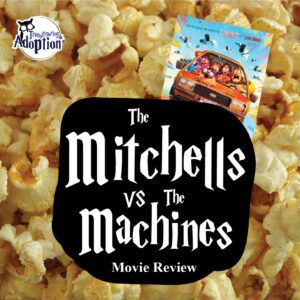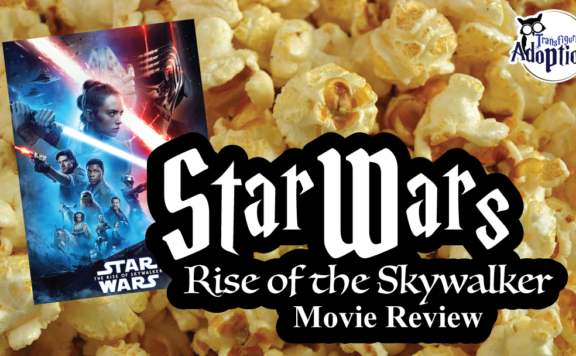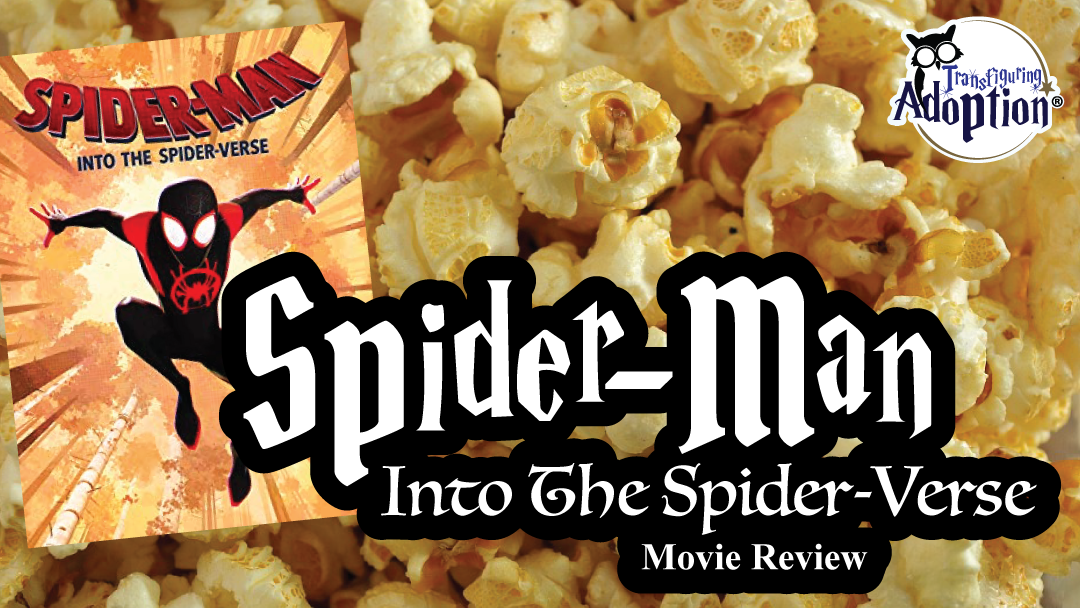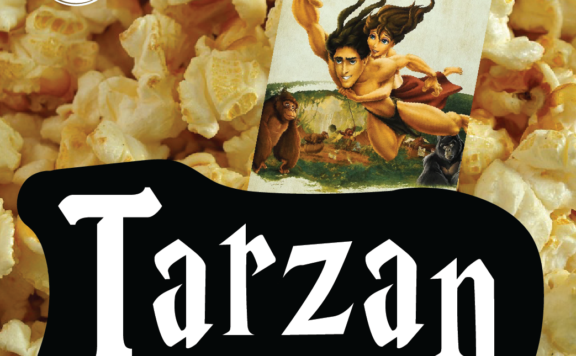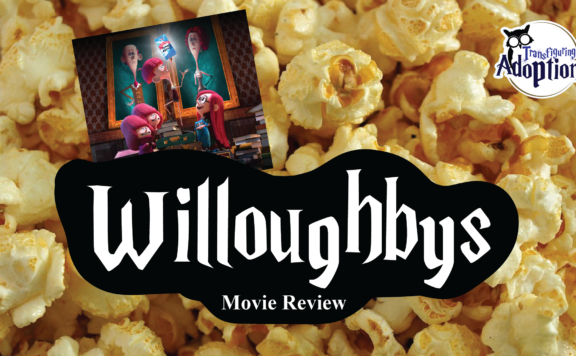Transfiguring Adoption’s Overview:
The Mitchells vs. The Machines is an animated family film released by Netflix that has flown surprisingly under the radar given how enjoyable it is. The movie was wacky and heartwarming all wrapped up together and a great exploration of what being a family means and how to navigate the challenges that inherently come with being a part of one.
The target audience seems to be pre-teens and teens, with the main character being a young adult getting ready to go off to college. The movie’s premise does revolve around an end-of-the-world scenario and there is a fair amount of peril and cartoon violence, which may be stressful for younger viewers. But overall, it’s likely to be a good choice to watch together as a family as the humor and content is relatable to all ages!
** Spoilers Could Be Ahead **
How Is This Relevant To Adoption & Foster Care?
While The Mitchells vs. the Machines does not directly address foster care or adoption, it has many overarching themes that are incredibly relevant. In the opening monologue, Katie (the main character) says, “Every family has its challenges… everyone wants to have the perfect family. But what is perfect?” This line so perfectly opens up the main idea of the movie which explores what it means to be a family, how to navigate challenges that arise, and how to grow and accept one another. While these concepts are relevant to all families, children who have experienced trauma likely have less understanding of how to be part of a healthy family and the dynamics of that, as we see Katie do in the movie. Katie has good relationships with her mother and younger brother but she struggles to connect with her father. They both want that connection but need help from the other family members (and a wild adventure with robots!) to finally get there. There are also two robots that the family ends up taking under their wing in an informal ‘adoption’ situation, which may resonate with children in care. The mom does not hesitate to say ‘you are a part of our family now’
Katie also struggles to fit in with her peers, something that foster and adoptive children will likely relate to as they have a tendency to struggle in all social relationships, not just familial ones.
Discussion Points:
- Navigating Family Dynamics
Katie starts out the movie by explaining that everyone wants a ‘perfect’ family but that there’s no such thing and every family has their own challenges. This remains a theme throughout the movie showing many relatable and common family struggles such as a teen going off to college, parents struggling to relate to their kids, and finding ways to bond and maintain relationships. This can be a great opportunity to talk about both the negative and positive ways that various members of the Mitchell family handle challenges and conflicts and how your family can strive to resolve your own conflicts in healthy and positive ways. - Comparing Yourself to Others
Throughout the movie we see the Mitchell family, especially the mom, compare themselves to others — constantly looking at social media and believing her neighbors are perfect and they should try to be more like that family. This can be a very easy thing to do, to look at small snapshots of other people or families and think that they have things better, especially with the prevalence of social media these days. This can be especially damaging in children and teens who are still developing their own identity and self-esteem. Use this opportunity to talk about the way that in the end it’s the Mitchells who end up being able to work together to save everyone and not the ‘perfect’ family they were comparing themselves to. Take time to talk about unique strengths and traits youth have and how they can utilize them. - “Changing Your Programming”
The two ‘defective’ robots end up joining the Mitchells and being adopted as part of the family, helping them with their mission to defeat PAL and the other robots. However, PAL overrides their programming and forces them to try to destroy the Mitchells and they follow her commands, believing that they have no choice but to follow their programing. However, later they see Mr. Mitchell, who has always hated and avoided technology, learn how to access the control panel and use technology to distract the robots and give Katie the change she needs to defeat PAL. The two robot-boys see this and proclaim that he ‘changed his programming’ by doing something out of character. This gives them the push they need to fight back against their own programming and help their family. For children in foster care they often believe they will always be defined by their trauma and what people expect them to be. This can be a great analogy of how they can overcome their ‘programming’ whether it’s their past or the expectations of others, and be anything they want to be.
Cautionary Points
- Rejection by Caregiver
Katie tries to show her dad a movie she made and he won’t even watch it instead talking about how she’s going to fail at college. We know from other context in the movie that her dad loves her and wants to connect with her but has a hard time relating. However, watching this scene might be very upsetting to children who have been similarly rejected by a caregiver (and in their case, it may not have come from a loving place). - Scenes of Family Disputes
There are a few scenes, especially at the beginning of the movie, where Katie and her dad get into somewhat heated arguments — yelling at one another and at one point he even breaks her computer. Katie says things about how she can’t wait to leave her family. All families experience disagreements and arguing from time to time, and the family resolves their disagreements afterwards and nothing terrible results from them. However, if children have experienced abusive situations watching these scenes with Katie and her dad might be upsetting and remind them of their own trauma. - Cartoon Violence/Peril
This is a PG-rated cartoon, so the actual violence and graphic content is minimal. However there are explosions, car chases, aliens shooting with laser guns and other chaotic and perilous situations. The Mitchells spend a lot of time running from danger and fighting robots. The middle hour of the film is almost non-stop action which may be challenging for children who have a hard time regulating emotions or coming down from an adrenaline high. - End-of-the-World Scenario
The main plot of the movie involves robots taking over the world and the Mitchells end up as the last people on earth in an apocalyptic world. This is a cartoon and there is a lot of humor, the thematic content may be a lot of kids who have a high level of anxiety or have experienced a lot of trauma. - Name-Calling/Bullying
While PAL is an AI as opposed to a human character, she is shown to express feelings and be somewhat sentient. When Mark introduces his new robots, he calls PAL ‘obsolete’ and’ meaningless trash’ and tosses her away. When the robots take over and take Mark captive they call him names, push him around, and bully him to ‘show him how it feels’. - Kidnapping/Abduction
When the robots take over the world, they hunt down every person and force them into ‘human fun pods’ which they then use to abduct the humans and imprison them all. Often when children are removed traumatically from their home and placed in care it can feel a lot like being ‘kidnapped’ and taken away to live with strangers. Because of this they may be sensitive to storylines involving capture and imprisonment, even in this case where it’s an unrealistic cartoon. - Parents Forcibly Removed from Children
When they are trying to fight the robots, the Mitchells are discovered and several scary drones come and capture Mr. and Mrs. Mitchell and drag them away while Katie and Aaron watch helplessly and scared. This scene may trigger memories of children being removed from biological parents or other traumatic separations such as a parent being arrested.
About the Author: Jenn Ehlers
Jenn is a central Virginia native who received her BA in Psychology from the University of Virginia in 2012. Since then she has worked for a local mental health agency and the Department of Social Services in various capacities and has been involved in her community’s efforts to create a Trauma Informed Network. Currently Jenn works in vocational rehab and mentors youth in foster care. When she isn’t working, Jenn enjoys writing stories, anything and everything Harry Potter, and spending time with her niece and nephew.
**Transfiguring Adoption is a nonprofit organization seeking to nurture growth in foster and adoptive families by giving a HOOT about their families. Transfiguring Adoption does not intend for its reviewers nor its review to be professional, medical or legal advice. These reviews and discussion guides are intended to help parents to better be able to connect and understand their children who come from traumatic backgrounds.

